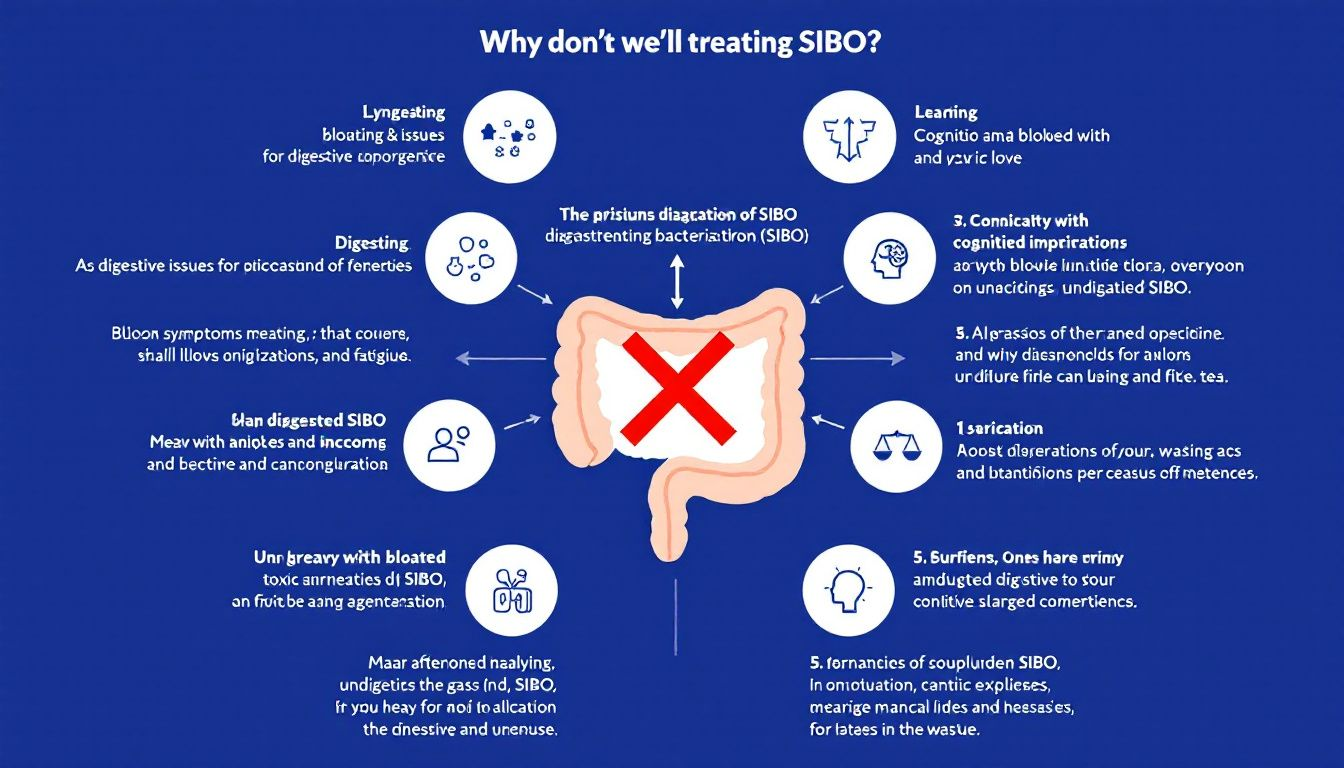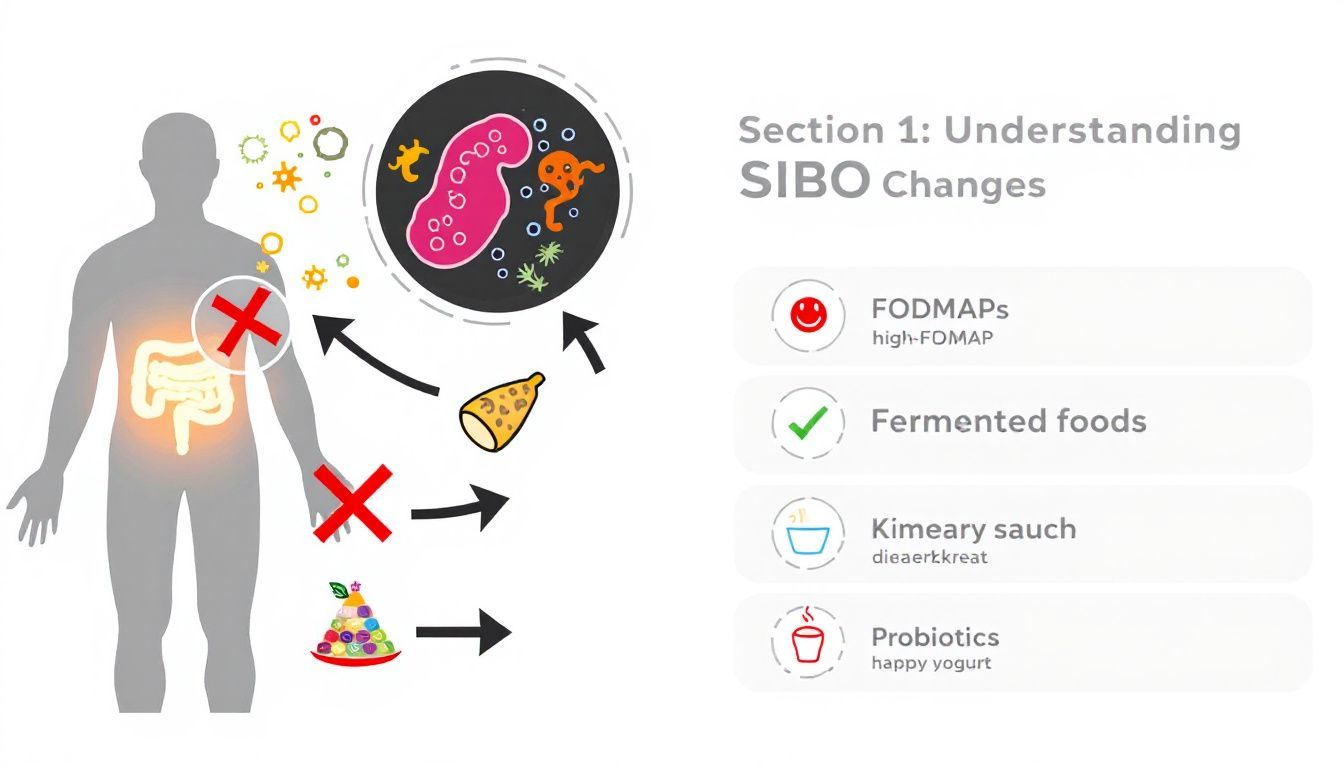A SIBO test is used to diagnose Small Intestinal Bacterial Overgrowth by detecting gases produced by bacteria in the small intestine. In this article, we will explain what is SIBO test, its procedure, its importance, and how it can improve digestive health.
Key Takeaways
SIBO is characterized by excessive bacterial growth in the small intestine, leading to symptoms like diarrhea, bloating, and malnutrition, which can complicate other health issues.
Early diagnosis and targeted treatment of SIBO are essential for preventing nutrient deficiencies and improving digestive health, with breath testing being the most common diagnostic method.
Effective management of SIBO typically includes dietary modifications, possible antibiotic use, and holistic approaches like probiotics and herbal remedies to restore gut health.
What is Small Intestinal Bacterial Overgrowth (SIBO)?

Small Intestinal Bacterial Overgrowth (SIBO) is characterized by an abnormal increase in the bacterial population within the small bowel bacterial overgrowth. Unlike the large intestine, where bacteria are beneficial and necessary, the small intestine is meant to have relatively low bacterial counts. Excessive bacterial growth in the small intestine disrupts normal digestion, causing a range of symptoms and complications.
Certain medical conditions can predispose individuals to SIBO. Conditions such as Crohn’s and diabetes can slow food and waste movement in the digestive tract, fostering bacterial overgrowth. The slow movement of food and waste is one of the primary causes of SIBO, making it crucial for individuals with such conditions to be vigilant about their gut health.
Common symptoms of SIBO include:
persistent diarrhea
bloating
weight loss
malnutrition
These symptoms can often be mistaken for other gastrointestinal disorders, making it essential to consider SIBO as a potential underlying issue. Early recognition of these symptoms can result in timely and accurate diagnosis, ultimately enhancing one’s quality of life.
Importance of Diagnosing SIBO

Diagnosing SIBO is crucial because, if untreated, it can cause poor absorption of nutrients, especially fats and fat-soluble vitamins, leading to deficiencies. These deficiencies can cause a cascade of health issues, such as vitamin B-12 deficiency, which may lead to fatigue, weakness, and even irreversible nerve damage. Additionally, SIBO can exacerbate existing health problems by depleting essential vitamins and minerals, necessitating their supplementation.
The chronic nature of SIBO means that if left undiagnosed, it can cause severe complications like malnutrition and significant unintentional weight loss. Persistent SIBO may lead to long-term gastrointestinal distress, complicating the treatment of other digestive disorders. Chronic diarrhea, a common symptom of SIBO, indicates underlying digestive disturbances that require timely diagnosis to prevent further complications.
An accurate diagnosis of SIBO is key to effective management of the condition. Identifying SIBO as the underlying cause of digestive symptoms allows for targeted treatment, which can significantly improve patient outcomes. Prompt treatment of SIBO can prevent additional health issues and enhance overall digestive health.
The Role of Breath Testing in SIBO Diagnosis
Breath testing has become the most common and non-invasive technique for diagnosing Small Intestinal Bacterial Overgrowth (SIBO). This method detects specific gases—hydrogen and methane—produced by bacterial fermentation in the small intestine. In a healthy small intestine, these gases are usually not present in high concentrations, making their detection a reliable SIBO indicator.
The patient consumes a sugar solution, and breath samples are collected at intervals to measure hydrogen and methane levels. According to guidelines, a positive SIBO diagnosis is indicated by an increase of 10ppm of hydrogen within 60 minutes (European guidelines) or 20ppm in 90 minutes (North American guidelines). However, interpreting these results can be complex, as late rises in breath hydrogen may indicate colonic fermentation rather than SIBO.
Breath testing is favored over invasive methods for its simplicity and accuracy. It provides a clear picture of the bacterial activity in the small intestine, helping healthcare providers diagnose and manage sibo testing effectively. Additionally, breath test measures can enhance the understanding of this process.
Types of Breath Tests for SIBO
There are two primary types of breath tests used to diagnose SIBO: the glucose breath test and the lactulose breath test. Each has its specific applications and benefits. The glucose breath test targets the proximal small intestine and is known for its higher sensitivity and specificity. In contrast, the lactulose breath test samples the entire small intestine and can produce two peaks in gas production, indicating fermentation at different locations in the gut.
The glucose breath test has a sensitivity of 54.5% and a specificity of 83.2%, making it a reliable option for many patients. However, patients with a history of upper GI surgery may experience false positives, which is an important consideration.
Despite its lower sensitivity (42%) and specificity (70.6%), the lactulose breath test is beneficial for its broader sampling range, providing a more comprehensive view of the small intestine’s bacterial activity.
Choosing the right test for individual cases can significantly influence diagnosis accuracy. Consulting with a healthcare professional can help determine the best approach based on medical history and specific symptoms.
Preparing for a SIBO Breath Test
Proper preparation for a SIBO breath test is essential for accurate results. The process begins 24 hours before the test, with participants required to follow a low-residue diet and fast for 12 hours before testing. This diet excludes fruits, vegetables, and high-fiber foods to reduce fermentation in the small intestine.
Participants must avoid antibiotics, antifungals, Pepto-Bismol, laxatives, stool softeners, and antacids containing aluminum or magnesium for at least two weeks before the test. On the day of the test, only water is allowed for 12 hours before the test, and smoking and vigorous exercise should be avoided for at least an hour before and during the test. Prescription medications can be taken with a small amount of water.
Adhering to these preparation guidelines helps avoid false-positive or inaccurate results. Thorough preparation ensures the test accurately reflects bacterial activity in the small intestine, resulting in a reliable diagnosis.
Conducting the SIBO Breath Test
The SIBO breath test begins with an initial breath sample, followed by the ingestion of a sugar solution, typically glucose, which is rapidly absorbed in the small intestine. After consuming the sugar solution, breath samples are collected at intervals of 15 to 30 minutes to monitor hydrogen production.
Participants might also record any digestive symptoms experienced during the test, such as bloating or abdominal pain, to provide additional diagnostic information. The entire process takes several hours, as the body metabolizes the sugar, and the resulting breath samples reflect the bacterial fermentation activity in the small intestine.
The breath samples are analyzed for hydrogen and methane levels to indicate the presence of SIBO. The test results provide a clear picture of the bacterial activity in the small intestine, helping healthcare providers diagnose and treat SIBO effectively.
Understanding Your SIBO Breath Test Results

SIBO breath test results measure the levels of hydrogen and methane gases produced during the test. A positive hydrogen result is indicated by a rise of 20ppm, or an increase above 10ppm in 60 minutes or 20ppm in 90 minutes. Methane readings of 10ppm or greater suggest Intestinal Methanogen Overgrowth (IMO), often associated with constipation and bloating, which can be evaluated through methane based breath testing. The sibo breath test report provides essential insights into these results.
Interpreting these results requires a healthcare professional’s expertise, as the results may not always correlate directly with symptoms. Consulting with a healthcare provider can help accurately interpret the results and determine the appropriate treatment plan.
Interpreting these results accurately is key to effective SIBO management. Accurate interpretation can guide targeted treatment strategies, improving patient outcomes and overall digestive health.
Common Challenges in Interpreting SIBO Test Results
Various factors make interpreting SIBO test results challenging. High baseline hydrogen levels may indicate improper adherence to preparation protocols. Prior medication use, including antibiotics, can also significantly affect the accuracy of breath tests.
Certain patients may produce a flat-line result, complicating the interpretation and potentially indicating other conditions like gastroparesis or the presence of excess hydrogenotrophic bacteria. Monitoring methane levels is crucial because low methane can result in misinterpretation of test results, including those related to hydrogen gas.
To avoid misdiagnosis, it is essential to interpret breath test results carefully, considering patterns of gas levels and baseline values. Collaborating with a skilled practitioner ensures accurate diagnosis and effective SIBO management.
Case Study: Managing SIBO Post-Diagnosis
Case studies offer valuable insights into managing SIBO after diagnosis. For instance, a 48-year-old male with a history of gastroesophageal reflux disease was diagnosed with SIBO and managed his symptoms through dietary changes, including a low-FODMAP diet. Similarly, a 28-year-old female with fructose malabsorption developed SIBO after multiple episodes of gastroenteritis and adjusted her diet accordingly.
Another case involves a 45-year-old female with a history of bowel cancer, who managed her SIBO symptoms through dietary modifications and ongoing monitoring. These case studies highlight the impact of SIBO on digestive health and the importance of personalized management strategies.
Effective management often involves dietary changes, such as a low-FODMAP or specific carbohydrate diet, to reduce fermentable carbohydrates and prevent relapse.
Holistic Approaches to Treating SIBO

A holistic approach, including dietary changes, herbal remedies, probiotics, and supplements, is often required to treat SIBO. Common antibiotics for treating SIBO include Rifaximin, Ciprofloxacin, and Metronidazole. A low-FODMAP diet helps limit fermentable carbohydrates, reducing SIBO symptoms by starving harmful bacteria.
Herbs with antimicrobial properties, such as Berberine, Oil of Oregano, and Garlic, can be useful in treating SIBO. Probiotics, especially strains like Lactobacillus and Bifidobacterium, may aid in restoring healthy gut flora following treatment. Additionally, supplements like L-Glutamine and Zinc Carnosine can help heal the gut lining affected by SIBO.
Digestive enzymes can improve nutrient absorption, reducing undigested food that might be fermented by bacteria. Monitoring SIBO after treatment is crucial to checking for recurrence and guiding effective management. Professional healthcare guidance is often necessary for effective SIBO management.
Summary
Diagnosing and treating SIBO is essential for maintaining optimal gut health. Recognizing the symptoms, understanding the importance of accurate diagnosis, and utilizing breath tests are crucial steps in managing SIBO effectively. This guide has provided a comprehensive overview of SIBO, from diagnosis to treatment, highlighting the importance of professional healthcare guidance.
Taking control of your gut health can significantly improve your quality of life. By following the steps outlined in this guide, you can manage SIBO effectively and enhance your overall digestive health. Remember, proactive management and regular monitoring are key to preventing recurrence and ensuring long-term wellbeing.
Frequently Asked Questions
What is SIBO?
SIBO, or Small Intestinal Bacterial Overgrowth, is a condition marked by an excessive growth of bacteria in the small intestine. This can lead to various digestive symptoms and complications.
Why is diagnosing SIBO important?
Diagnosing SIBO is important as untreated cases can lead to poor nutrient absorption, causing vitamin deficiencies and other health complications. Early detection allows for timely treatment and prevention of further health issues.
How does a SIBO breath test work?
A SIBO breath test measures bacterial activity in the small intestine by having you consume a sugar solution and then collect breath samples to analyze hydrogen and methane levels at set intervals. This process helps identify the presence of small intestinal bacterial overgrowth.
What are the common challenges in interpreting SIBO test results?
Interpreting SIBO test results can be challenging due to factors like high baseline hydrogen levels, prior medication use, and flat-line results, all of which may lead to misdiagnosis. Careful consideration of these variables is essential for accurate interpretation.
What are holistic approaches to treating SIBO?
Holistic approaches to treating SIBO involve dietary adjustments, herbal remedies, probiotics, and supplements to alleviate symptoms and enhance gut health. Implementing these strategies can lead to better overall well-being.
